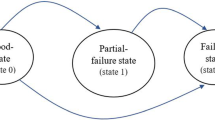Abstract
The concept of information‐based maintenance is that of updating decisions for inspection, repair, and maintenance scheduling based on evolving knowledge of operation history and anticipated usage of the machinery as well as the physics and dynamics of material degradation in critical components. This paper presents a stochastic model of fatigue crack damage in metallic structures for application to information‐based maintenance of operating machinery. The information on operation history allows the stochastic model to predict the current state of damage, and the information on anticipated usage of the machinery facilitates forecasting the remaining service life based on the stress level to which the critical components are likely to be subjected. The Karhunen‐Loève expansion for nonstationary processes is utilized for formulating the stochastic model which generates the crack length statistics in the setting of a two‐parameter log normal distribution. Hypothesis tests are built upon the (conditional) probability density function of crack damage that does not require the solution of stochastic differential equations in either Wiener integral or Itô integral settings. Consequently, structural damage and remaining life of stressed components can be predicted to make maintenance decisions in real time. The damage model is verified by comparison with experimental data of fatigue crack statistics for 2024‐T3 and 7075‐T6aluminum alloys. Examples are presented to demonstrate how this concept can be applied to hypothesis testing and remaining life prediction.
Similar content being viewed by others
References
V.V. Bolotin, Prediction of Service Life for Machines and Structures, ASME Press, 1989.
J.L. Bogdanoff and F. Kozin, Probabilistic Models of Cumulative Damage, Wiley, New York, 1985.
F. Casciati, P. Colombi and L. Farvelli, Fatigue crack size probability distribution via a filter technique, Fatigue & Fracture of Engineering Materials & Structures 15(1992)463-475.
O. Ditlevsen and R. Olsen, Statistical analysis of the Virkler data on fatigue crack growth, Engineering Fracture Mechanics 25(1986)17-195.
K. Fukunaga, Introduction to Statistical Pattern Recognition, 2nd ed., Academic Press, Boston, 1990.
H.E. Garcia and A. Ray, State-space supervisory control of reconfigurable discrete event systems, International Journal of Control 63(1996)767-797.
H. Ghonem and S. Dore, Experimental study of the constant probability crack growth curves under constant amplitude loading, Engineering Fracture Mechanics 27(1987)1-25.
A. Hoyland and M. Rausland, System Reliability Theory: Models and Statistical Methods, Wiley-Interscience, New York, 1994.
H. Ishikawa, A. Tsurui, H. Tanaka and H. Ishikawa, Reliability assessment based upon probabilistic fracture mechanics, Probabilistic Engineering Mechanics 8(1993)43-56.
A.H. Jazwinski, Stochastic Processes and Filtering Theory, Academic Press, New York, 1970.
P.E. Kloeden and E. Platen, Numerical Solution of Stochastic Differential Equations, Springer, Berlin, 1995.
Y.K. Lin and J.N. Yang, A stochastic theory of fatigue crack propagation, AIAA Journal 23(1985)117-124.
J.C. Newman, A crack-closure model for predicting fatigue crack growth under aircraft loading, in: Methods and Models for Predicting Fatigue Crack Growth under Random Loading, ASTM STP 748, 1981, pp. 53-84.
S. Özekici (ed.), Reliability and Maintenance of Complex Systems, NATO Advanced Science Institutes (ASI) Series F: Computer and Systems Sciences, Vol. 154, Berlin, Germany, 1996.
A. Ray and S. Phoha, Integrated prognostics, maintenance, and life extending control, in: Modern Computer-Aided Maintenance: Methodology and Practice, eds. B. Wang and J. Lee, Chapman and Hall, London, UK, 1998.
A. Ray and S. Tangirala, Stochastic modeling of fatigue crack dynamics for on-line failure prognostics, IEEE Trans. Control Systems Technology 4(1996)443-451.
A. Ray and S. Tangirala, A nonlinear stochastic model of fatigue crack dynamics, Probabilistic Engineering Mechanics 12(1997)33-40.
G.I. Schueller (ed.), Special issue on Reliability of Structural and Mechanical Components under Fatigue, Engineering Fracture Mechanics 53(1996).
K. Sobczyk and B.F. Spencer, Jr., Random Fatigue: Data to Theory, Academic Press, Boston, MA, 1992.
B.F. Spencer, J. Tang and M.E. Artley, A stochastic approach to modeling fatigue crack growth, The AIAA Journal 27(1989)1628-1635.
S. Suresh, Fatigue of Materials, Cambridge University Press, Cambridge, UK, 1991.
D.A. Virkler, B.M. Hillberry and P.K. Goel, The statistical nature of fatigue crack propagation, ASME Journal of Engineering Materials and Technology 101(1979)148-153.
J.N. Yang and S.D. Manning, A simple second-order approximation of stochastic crack growth analysis, Engineering Fracture Mechanics 53(1996)677-686.
Rights and permissions
About this article
Cite this article
Ray, A., Phoha, S. Stochastic modeling of fatigue crack damagefor information‐based maintenance. Annals of Operations Research 91, 191–204 (1999). https://doi.org/10.1023/A:1018993505714
Published:
Issue Date:
DOI: https://doi.org/10.1023/A:1018993505714




